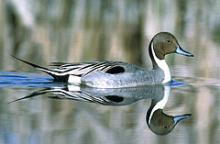Evidence for intercontinental parasite exchange through molecular detection and characterization of haematozoa in northern pintails (Anas acuta) sampled throughout the North Pacific Basin

Empirical evidence supports wild birds as playing a role in the interhemispheric exchange of bacteria and viruses; however, data supporting the redistribution of parasites among continents are limited. In this study, the hypothesis that migratory birds contribute to the redistribution of parasites between continents was tested by sampling northern pintails (Anas acuta) at locations throughout the North Pacific Basin in North America and East Asia for haemosporidian infections and assessing the genetic evidence for parasite exchange. Of 878 samples collected from birds in Alaska (USA), California (USA), and Hokkaido (Japan) during August 2011–May 2012 and screened for parasitic infections using molecular techniques, Leucocytozoon, Haemoproteus, and Plasmodium parasites were detected in 555 (63%), 44 (5%), and 52 (6%) samples, respectively. Using an occupancy modeling approach, the probability of detecting parasites via replicate genetic tests was estimated to be high (ρ > 0.95). Multi-model inference supported variation of Leucocytozoon parasite prevalence by northern pintail age class and geographic location of sampling in contrast to Haemoproteus and Plasmodium parasites for which there was only support for variation in parasite prevalence by sampling location. Thirty-one unique mitochondrial DNA haplotypes were detected among haematozoa infecting northern pintails including seven lineages shared between samples from North America and Japan. The finding of identical parasite haplotypes at widely distributed geographic locations and general lack of genetic structuring by continent in phylogenies for Leucocytozoon and Plasmodium provides evidence for intercontinental genetic exchange of haemosporidian parasites. Results suggest that migratory birds, including waterfowl, could therefore facilitate the introduction of avian malaria and other haemosporidia to novel hosts and spatially distant regions.
Ramey, A. M., J. A. Schmutz, J. A. Reed, G. Fujita, B. D. Scotton, B. Casler, J. P. Fleskes, K. Konishi, K. Uchida, and M. J. Yabsley. 2015. Evidence for intercontinental parasite exchange through molecular detection and characterization of haematozoa in northern pintails (Anas acuta) sampled throughout the North Pacific Basin. International Journal for Parasitology: Parasites and Wildlife 4:11–21.
